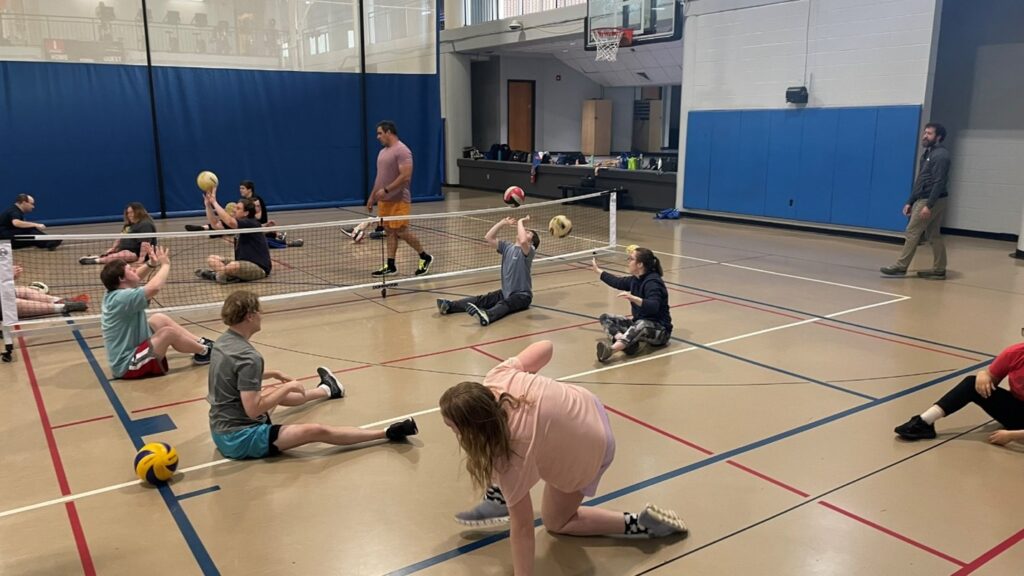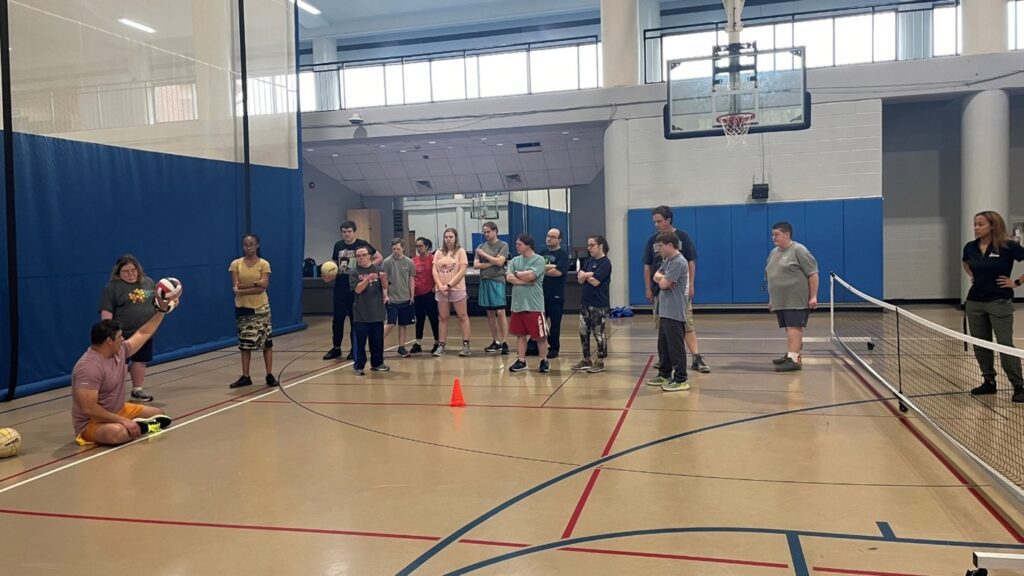By Alex X. Martinez, NCHPAD Content & Inquiry Manager
Participation in physical leisure activities, such as exercising and outdoor recreation, can lead to many social, psychological and health benefits. There is evidence to suggest that people with disabilities have limited access to inclusive recreation programs in their communities. In my experience as an advocate for inclusion and an adapted sports coach, I have seen a disparity based on location alone on access to quality adapted recreation programs.
Community partnerships are a great way to promote inclusion and opportunities for individuals to participate in health and wellness programs. Based on that need, I decided to reach out to a local recreation center and seek a partnership by offering a new activity that could be delivered within the recreation program activities. This collaboration will allow the participants to learn and practice the Paralympic sport of sitting volleyball.
The Partner
The Hoover Recreation Center (HRC) is a fitness and recreation facility that offers health and wellness programs to the citizens of Hoover, Alabama. The EXPLORE program at the HRC is designed to meet the needs of individuals with disabilities. This program utilizes community resources to expand the opportunities for the participants to engage in leisure and obtain recreation knowledge that will expand their opportunities to improve their health and wellness. The program is designed and implemented by Certified Therapeutic Recreation Specialists.
Sitting Volleyball
Sitting volleyball is a modified version of traditional volleyball designed to accommodate individuals with disabilities, particularly those with mobility impairments. Sitting volleyball is played on a smaller court with a lower net. It emphasizes teamwork, coordination and skill development. However, despite its many benefits, opportunities for individuals to learn and play sitting volleyball can be limited. Sitting volleyball can be played at both recreational and competitive levels, and it is a sport that has been in the Summer Paralympic program since 1980.

Common Interest is Key
In my role with NCHPAD (and as a citizen of Hoover), I had the opportunity to collaborate with Hoover city officials and the Lakeshore Foundation (a local paralympic training site) to promote inclusion in events, activities and community resources.
I have completed many of these non-formal partnerships before, including committee work as an inclusion specialist on the EXPLORE Inclusive Playground and Hartford Nationals (the biggest adapted sports competition in the United States) along with the city-wide strategic plan for parks and recreation. I also worked with Mr. Justin, a librarian and musician from the Hoover City Library, on the voice narration of the children’s book, Where is Mi Amigo, Pedro?
The city of Hoover and its officials share a common interest with NCHPAD in creating inclusive recreation and leisure opportunities for people with disabilities. This shared interest facilitated collaboration and ease in providing sitting volleyball opportunities in the community.
Adapted Sports Experience
Through this experience, participants had the opportunity to learn the basic skills of sitting volleyball. The program consisted of 6 seventy-five-minute lessons. The program was instructed by former Paralympian Bob Lujano, Therapeutic Recreation Instructors Jayla Maye and Madison Childers, and me. The objectives of the program included:
- Learning basic rules of the game, such as rotations and court boundaries.
- Practicing body movement and positioning to perform sport-related skills.
- Learning and practicing sports skills such as serving, ball contact and volleying over the net.
- Practicing game-like drills to enhance the mastery of sport-related skills.
- Engaging socially with peers in a recreational-type setting while practicing a sport.
- Increasing disability visibility and representation by receiving instruction from a disabled recreation expert.
Through the lessons, participants were encouraged to challenge themselves by modifying the difficulty levels in the drills by altering the distance, the weight of the ball and the progression of the drills. To ensure enjoyment, the participants were encouraged to choose the levels of difficulty based on their preference. For example, participants had the option of performing the skill of overhead setting by setting the ball or catching and throwing with two hands.

Impact
For individuals with disabilities, participating in sports can often feel daunting due to perceived barriers and lack of accessibility. Through this partnership, participants were able to break down this barrier by participating in a welcoming environment where everyone was included and valued. I am hopeful that encouraging participants to challenge themselves helps promote confidence-building and enjoyment of physical activity.
Fostering Community
Sport has a remarkable ability to bring people together by fostering connections and camaraderie. Through sitting volleyball lessons, participants learn new skills and form meaningful friendships and support networks. The recreation center serves as a gathering place where individuals from diverse backgrounds come together to share their passion for sports and celebrate each other’s achievements.
Promoting Health and Well-being
Engaging in regular physical activity is essential for maintaining a healthy lifestyle, both physically and mentally. Sitting volleyball provides a fun and effective way for individuals with disabilities to stay active, improve their strength and endurance, and enhance their overall well-being. Moreover, the supportive environment created by the recreation center and sports coaches encourages participants to set and achieve personal fitness goals, leading to greater self-esteem and resilience.
Future Implications
The impact of providing opportunities for people to engage in inclusive physical activity in community settings extends beyond the sports lessons that were offered. It establishes a foundation and a precedent for organizations such as a community recreation center to deliver a message of inclusion to the community. I hope similar programs emerge and more opportunities for adapted physical activity recreation are included in community recreation settings.
Attitude is one of the most impactful barriers felt among the disabled population. The visibility of inclusion can positively reshape attitudes and perceptions toward disability. Staff and members from the recreation center became spectators during the lessons, and some engaged in hallway conversations with me about the importance of providing these types of recreation opportunities. Through these conversations, I felt a sense of pride because the activities were offered in their community recreation center. I hope those who witnessed this initiative are inspired to embrace diversity, challenge stereotypes and advocate for social change. They learn that sports are for everyone, regardless of ability, and by working together, we can create a more inclusive society.
Personal Impact
It is well-known that community volunteerism can contribute to better wellness of those who engage in it. It is recommended that corporations and organizations provide opportunities for their staff to volunteer in their community to experience the wellness benefits of engaging in social initiatives. Through this opportunity, I was able to experience it myself. After every session, I felt accomplished, energized, inspired, welcomed and valued. It helps that the staff and people who participated embraced me even from the very first conversation that I had with the parks and recreation administration during the planning phase of the project. Professionally, this experience allowed me to work in a practical setting with people with intellectual and developmental disabilities. I can share my experience and lessons learned with others who are trying to engage in similar work. The need to share experiences and highlight how partnerships can help promote inclusion led me to write this blog.
I am extremely grateful for this collaboration between NCHPAD, the Hoover Recreation Center and the members who participated.
References:
- Bedini, L. A. (2000). ” Just sit down so we can talk:” perceived stigma and community recreation pursuits of people with disabilities. Therapeutic Recreation Journal, 34(1), 55-68.
- Han, A., Kim, J., & Kim, J. (2019). Coping strategies, social support, leisure activities, and physical disabilities. American journal of health behavior, 43(5), 937-949.
- Leung KM, Chung PK, Chu W, Ng K. Physical and psychological health outcomes of a sitting light volleyball intervention program on adults with physical disabilities: a non-randomized controlled pre-post study. BMC Sports Sci Med Rehabil. 2021 Aug 28;13(1):100. doi: 10.1186/s13102-021-00328-7. PMID: 34454587; PMCID: PMC8403424.
- Carbone, P. S., Smith, P. J., Lewis, C., & LeBlanc, C. (2021). Promoting the participation of children and adolescents with disabilities in sports, recreation, and physical activity. Pediatrics, 148(6).
- Reber L, Kreschmer JM, James TG, Junior JD, DeShong GL, Parker S, Meade MA. Ableism and Contours of the Attitudinal Environment as Identified by Adults with Long-Term Physical Disabilities: A Qualitative Study. International Journal of Environmental Research and Public Health. 2022; 19(12):7469. https://doi.org/10.3390/ijerph19127469
